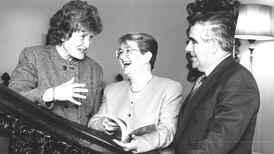This week Ireland takes over the political leadership of an organisation which safeguards the rights of and represents some 765 million people. The binding obligations arising from membership mean a remit that runs from Novosibirsk in Siberia in the east, to Reykjavik in the west, and south from the Azores to Istanbul.
Europe's oldest inter-governmental forum, the Council of Europe, based in Strasbourg, now sets human rights standards for its 41 member states and the five or six aspiring members on its periphery, while its court and the fundamental text of the council, the European Convention on Human Rights, have been the inspiration and source of law for later imitators such as the Inter-American Court, the African Charter on Human and People's rights, and ultimately the newly agreed international war crimes court.
The council in its 50-year history has been responsible for some 160 conventions, the equivalent of 10,000 bilateral treaties, whose scope runs from protecting computer data to common approaches to football hooliganism, nature, media culture, environment, torture, the treatment of national minorities, racism, and regulating bioethics.
Yet, as Ireland leads the council into the new millennium it faces a new and in many ways more difficult phase of its history, when the relative certainties of an organisation based unambiguously on the rule of law give way to the shifting sands of political compromise and expediency.
Where the two meet the credibility of the organisation is on the line, as Denis Huber point out in his new book on the tumultuous last 10 years of the council, A decade which made history.
When new member states on the road to democracy, pledged to programmes of reform, call a halt, like the Ukraine, or go to war with their own citizens, like Russia, or, like Turkey, refuse to implement the decisions of the court, where should the council stand on their membership rights?
And where does the council fit in the complex architecture of Europe's multiple multinational organisations? The council, the EU, NATO, the Organisation of Security and Co-operation in Europe. . . each has a different but complementary role. "Complementarity" is now the buzzword of European diplomatic theory.
But with the EU setting out on an ambitious enlargement road it is likely that the two organisations will see their membership convergence as so substantial that the idea of a merger, proposed recently by the Fine Gael leader, Mr John Bruton, will not appear utopian.
That tendency will certainly be reinforced by the EU's desire to cloak itself in a citizen-friendly human rights dimension, and Mr Bruton was commended last week as "visionary" for his contribution to the debate by the council's new Austrian Secretary General, Mr Walter Schwimmer.
On May 5th, 1949, in London's Saint James's Palace the treaty constituting the Statute of the Council of Europe was signed by 10 countries: Belgium, France, Luxembourg, the Netherlands, the United Kingdom, Ireland, Italy, Denmark, Norway and Sweden.
Membership grew slowly to 18 in 30 years, and to 23 by 1989 when Finland joined. But by 1993 there were 32 members. When the Soviet Union and Yugoslavia imploded they alone created 20 new states; most are now members or candidates.
These extraordinary last 10 years have seen the council as the diplomatic mirror of the revolutions wrought across eastern Europe, acting as the bridge between totalitarianism and democracy. The chamber of the Parliamentary Assembly has seen moments of high history, perhaps none more so than when, on July 6th 1989, Mikhail Gorbachev spoke of "consigning to oblivion the postulates of the Cold War".
He quoted the words of Victor Hugo: "The day will come when you, France, you Russia, you Italy, you England, you Germany - all of you, the nations of the continent - will, without losing your distinguishing features and your splendid distinctiveness, merge inseparably into some high society and form a brotherhood . . . The day will come when the only battlefield will be markets open for trade and minds open to ideas."
Francois Mitterrand would speak of his dream of a European confederation. Helmut Kohl, of Germany's unification. Vaclav Havel, "that we must not be afraid to dream of the seemingly impossible". Mary Robinson, of the universality of human rights and of her conception of the council, coming of age, as equivalent to Ireland's new "fifth province".
"Where is it?" she asked. "It is that place within each of us, that place that is open to the other, that swinging door that allows us to venture out and others to venture in . . . an Ireland of reconciliation and healing."
Yet, new types of members would mean new ways of working. Should the council admit those who do not meet basic standards of democracy and rights in the hope that membership will assist the process of doing so? Where states commit themselves to completing the requirements of membership once they have joined, unlike the EU where the equivalent, the acquis has to be completed beforehand.
For Georgia, the newest member, that has meant over 30 new commitments, ranging from the settling of internal disputes to the enhancement of local government.
For the council it means an ever growing burden of monitoring and facing up to the persistent nagging claim that it is toothless in enforcement, able only to rely on moral authority, and particularly prone to pressure from the great powers. Mr Schwimmer insists they must take risks to help the new member states and points to a remarkable success story. "No-one would have believed in 1949 that a Georgian former minister of foreign affairs of the Soviet Union, Mr Eduard Shevardnadze, could come to Strasbourg, direct from participating in a NATO summit, with the aim of signing up his country, and the land of Stalin's birth, to the Council of Europe."







